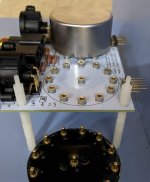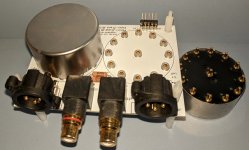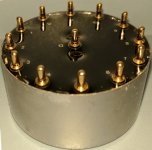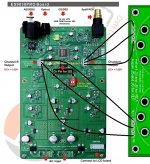The real measured inductance (2-3 years after its manufacturing I think) of this EI (marked as 430H on photo) transformer is ~180H now at 100Hz. So the answer to your question pretty simple: difference in inductances are due to different plates permability within different transformers and due to wiring differences within one transformer (a bit less\more resistance), which are escalated over the time. To be honest the difference in pair of transformers even within 5-10% is a very good result as in the real transformer (not in theoretical, but in real) there is no inductive resistance only. Transformer is very complex thing and it is simply not possible to rely all the things needed for sound\music on inductances only, especcially at 100Hz only. But I believe the point is not that the object was old or new or in their absolute values of inductances. I believe mentioned transformers are still very good in terms of quality\cost. The more inductance you can get on the same dimmensions\wiring - the better perfomance - no questions. With hope that benefits (permability) will not go down over the time significally...
Sure they can measure at any frequency, but this particular measurement showned on photo (declared in specs) done at 100Hz.
The really interesting\sensitive things happens in another aspects of transformers. Seems that such regular (EI thick plate based) transformers simply stops to be transformers at higher frequencies if they have such a big amount of inductance\wire length, because the capacitive resistances between coils becames dominant over others. Transformer becomes... becomes... becomes capacitor
And if takes into account that 1:1 transformers are poorly suitable with current-type DACs (I believe DSC works better in current-output mode, similar to ES90x8 btw), and taking into account that step-up transformers works as LPF what is higly needed for DACs (Delta-sigma\SDM output especcially, remember Rasmussen filtering) - things becomes clearer a bit.
I know why this approach poorly works on other step-up transformers and clearly understand why people prefer 10k:10k over 600:10k of the same-type transformer, but it is another storry...
Clearer just "a bit" - because measurements very often are going in parallel or even in wrong direction when you comes closer and closer to the music in opposite to sound.
yunyun, I suggest to make the necessary comparative measurements from someone else, but AFTER real comparative listening within system that have no limit after DAC in terms of quality of following components. Reading your posts, I understand that I will always stays too interested person in this thread to to satisfy your curiosity
I can't fully agree with you said what the more inductance you can get on the same dimmensions\wiring - the better perfomance - no questions.
The higher the inductance will get the better the low-frequency signal but the high-frequency will be worse. That is to say that the inductance of the transformer is not a pursuit of higher inductance, and it needs to be balanced in many aspects. Lundahl's transformer is designed to pay attention to high-frequency transparency, but the low-frequency listening is thin.
I hope that you can complete the PCB for your transformer as soon as possible, otherwise I will difficulty use it to do real comparative listening.
Last edited:
Hi sumotan. Very good question! Yes, TDA1541 is very musical DAC, but it has some dificulties.
Previously I have used transformers with special DC-offset coil. But the price for such transformer looks a bit too costly compared to right-implemented regular transformer without special offset-coil. The difference between both approaches in THD measurements mainly was below 150Hz and was not very much (at least not 10 times less with offset coil as I remember - it was really not very hearable). And if taking into accout that DIYers mostly can not \ not want to make deal with additional complexity (extra PSU with needed voltage) during connectivity... I decided to provide simple one primary coil solution only (between Iout and gnd).
Anyway I think it is better to ask Dubai2000 about his experience with my transformers for TDA1541.
But time to time I am still wondering if it is possible to avoid dc-offset if to use 1541 in balanced mode (2x1541)?.. with simple connection of primary coil between Iout+ and Iout- with coil's CT at GND?.. But the demand for 1541 in our days is not high enough to allow me spend time for such experiments now, sorry...
Thank you kindly for the reply .
Cheers


This "DSC" i/v board can be considered as some of universal type for different DACs based on my transformers. For the prototype was taken a printed circuit board from Pavel (ppy). Genuine RCAs on it are really very well manufactured. Сosty compared to other PCBs because of more expensive parts used on it. But I believe the components on it are the same now with that which are used many hi-end audio manufacturers.
The price for assembled PCB including receptacles (really costy parts) and genuine RCAs\XLRs even without transformers will be more than 100$. How much exactly - do not want to calculate without real demand
I have a pair of prefinished transformers made by silver wire. Turns ratio is 1:4. Can be splitted up to 0.5+0.5:2+2 for owner before shielding can finalization.
Price is $1000 for pair including WW EMS shipment. Details via PM please.
Sold.
I got a bisesik transformer for Ian ES9038Q2M (XMOS + FifoPi + dual mono ES9038Q2M). Thank you very much!
Earlier as I/V was the I/V STD standard.
When I turned it on for the first time I couldn't tear myself away for 5 hours
The sound was a little different, first impression: more high frequencies and less bass. After a while I realized that the bass is not lacking, it is different, strong but more punctual, it does not cover other ranges. Better for me.
What surprised me was the space. I listen on headphones and suddenly some new sounds appeared somewhere in the back of my head.
Amazing....
Super product...
Thanks again bisesik!
Earlier as I/V was the I/V STD standard.
When I turned it on for the first time I couldn't tear myself away for 5 hours
The sound was a little different, first impression: more high frequencies and less bass. After a while I realized that the bass is not lacking, it is different, strong but more punctual, it does not cover other ranges. Better for me.
What surprised me was the space. I listen on headphones and suddenly some new sounds appeared somewhere in the back of my head.
Amazing....
Super product...
Thanks again bisesik!
Super product...
Thanks again bisesik!
Thanks for kind words. You are welcome!
- Home
- Vendor's Bazaar
- Output transformers for DACs



